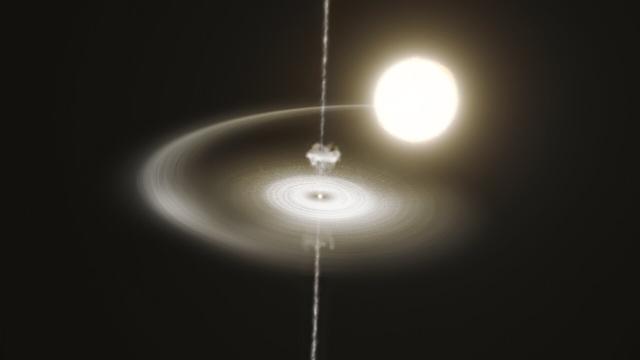A rapidly spinning dead star’s wacky fluctuations in brightness are due to the extreme environment surrounding the object, according to a team of astronomers who observed it.
Pulsars are fast-spinning magnetic star remains that spew electromagnetic radiation. They’re sometimes called “cosmic lighthouses,” because the jets of light they reliably emit can be precisely timed to understand other aspects of the cosmos, like the ripples in spacetime we call gravitational waves.
The pulsar recently scrutinized by a team of astronomers is named PSR J1023+0038, or J1023. It sits about 4,500 light-years from Earth in the constellation Sextans, where it spins around and yanks material from its companion star. The accreted material has formed a disc around the pulsar and slowly falls into it.
Now, astronomers have published new findings about the pulsar in Astronomy & Astrophysics that they say suggests activity in the accretion disc’s innermost regions—specifically, ejections of matter—are responsible for the weird fluctuations of the object.
“We have witnessed extraordinary cosmic events where enormous amounts of matter, similar to cosmic cannonballs, are launched into space within a very brief time span of tens of seconds from a small, dense celestial object rotating at incredibly high speeds,” said Maria Cristina Baglio, an astronomer at New York University Abu Dhabi and the study’s lead author, in a European Southern Observatory release.
Over the last 10 years, the pulsar has been jumping between two “modes”—one in which the dead star emits higher frequency visible light, ultraviolet light, and X-rays, and another in which the pulsar grows dim and emits radio waves. The modes last from anywhere between a few seconds and several minutes.
Observations of the pulsar were taken by the ESO’s Very Large Telescope and New Technology Telescope, as well as the Atacama Large Millimeter/Submillimeter Array (ALMA). The pulsar made 280 mode switches during the two-night observing window.
“We have discovered that the mode switching stems from an intricate interplay between the pulsar wind, a flow of high-energy particles blowing away from the pulsar, and matter flowing towards the pulsar,” said study co-author Coti Zelati, an astronomer at the Italian National Institute for Astrophysics (INAF).
In the pulsar’s lower-frequency mode, matter falling to the pulsar’s surface is pushed out through the pulsar’s jet. But the matter surrounding the pulsar heats up in the process, and is heated up by wind blowing from the star, causing the pulsar’s higher mode. The “cosmic cannonballs” ejected by the jet are blobs of heated matter being expelled, the researchers concluded. Once the pulsar surrenders that heated material, it reverts back to its low-frequency mode.
Pulsars are considered reliable, so much so that they’re being used to detect the gravitational wave background. So to witness a pulsar with a stuttering history of emissions was puzzling…until now!
